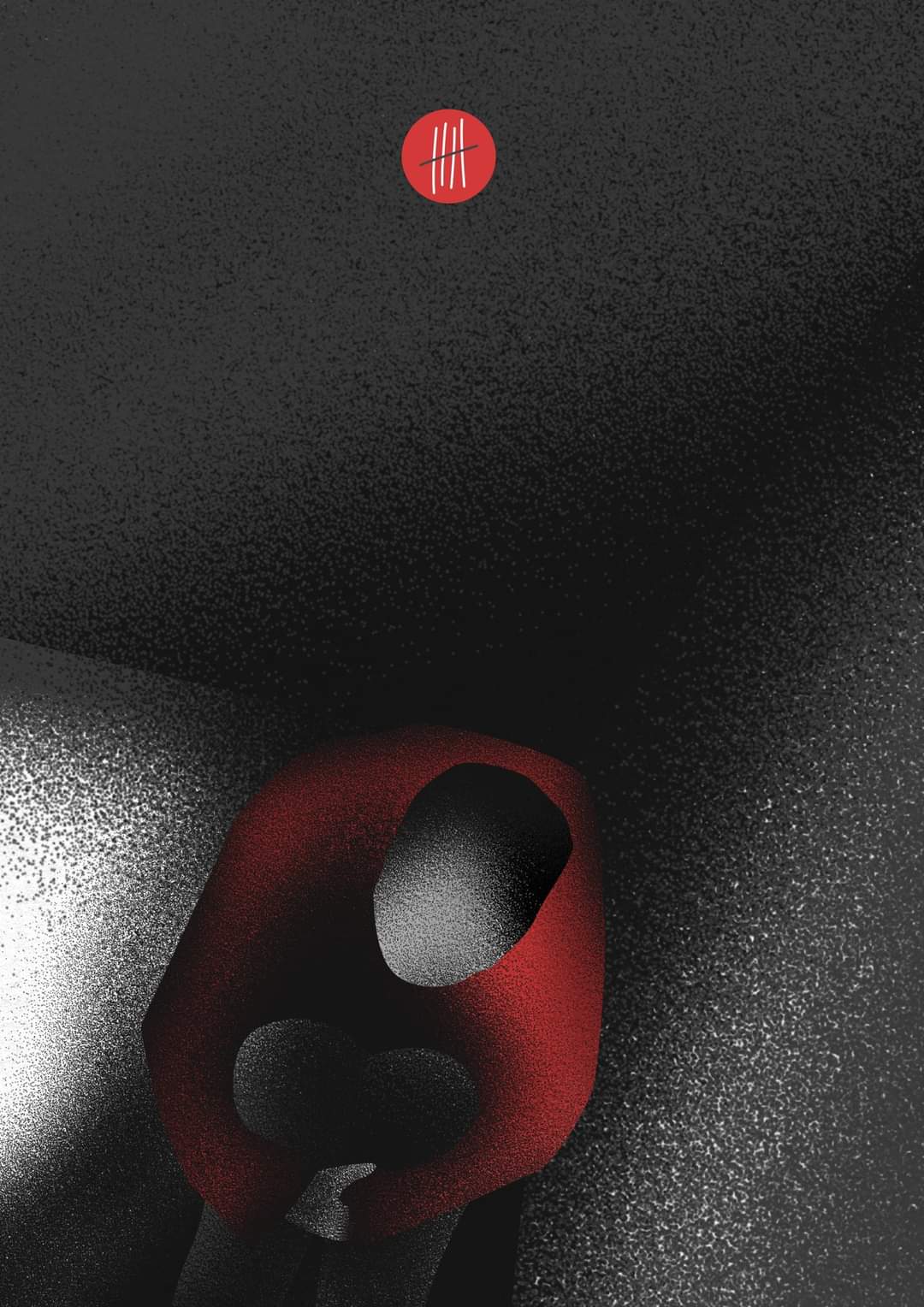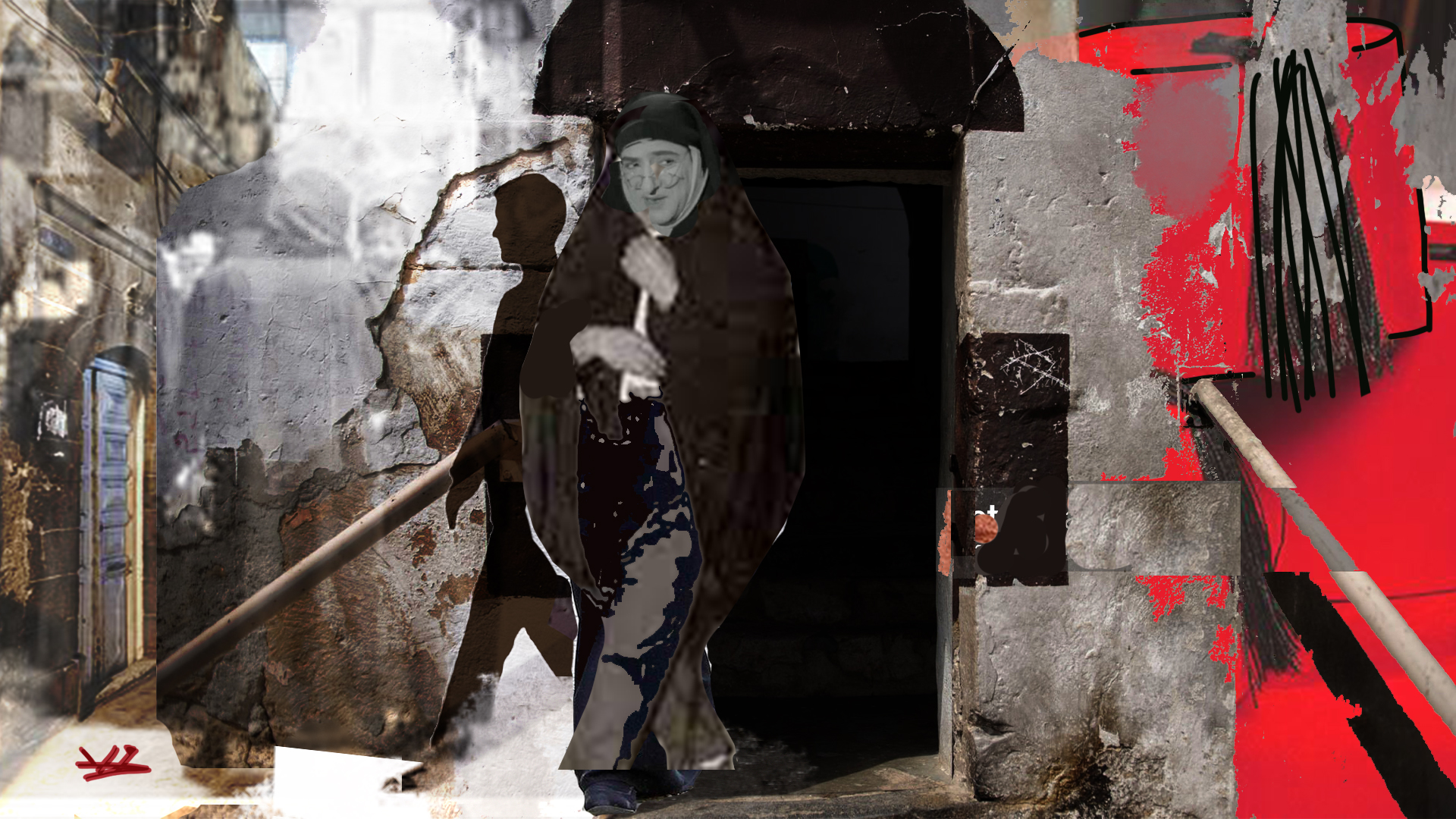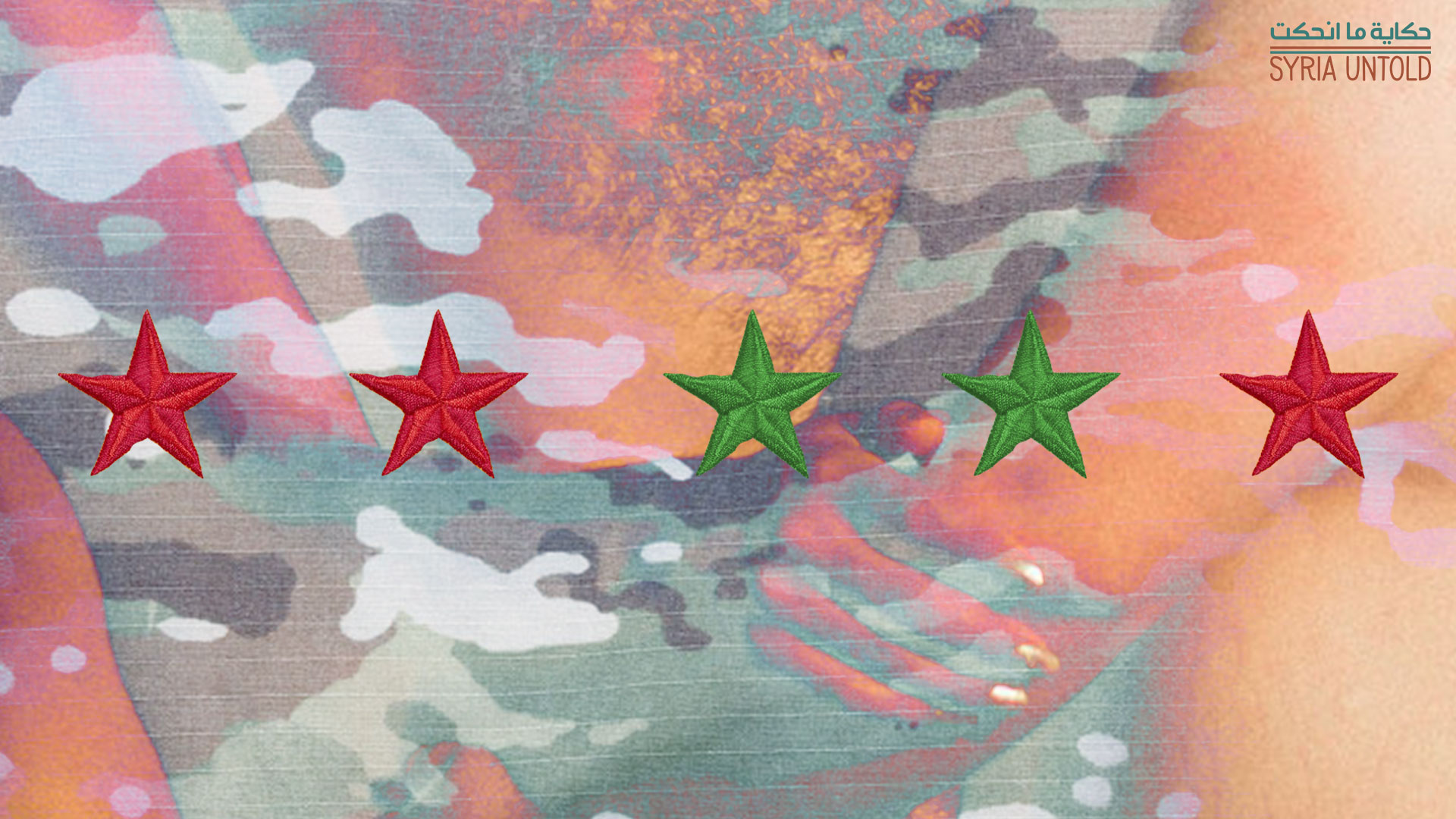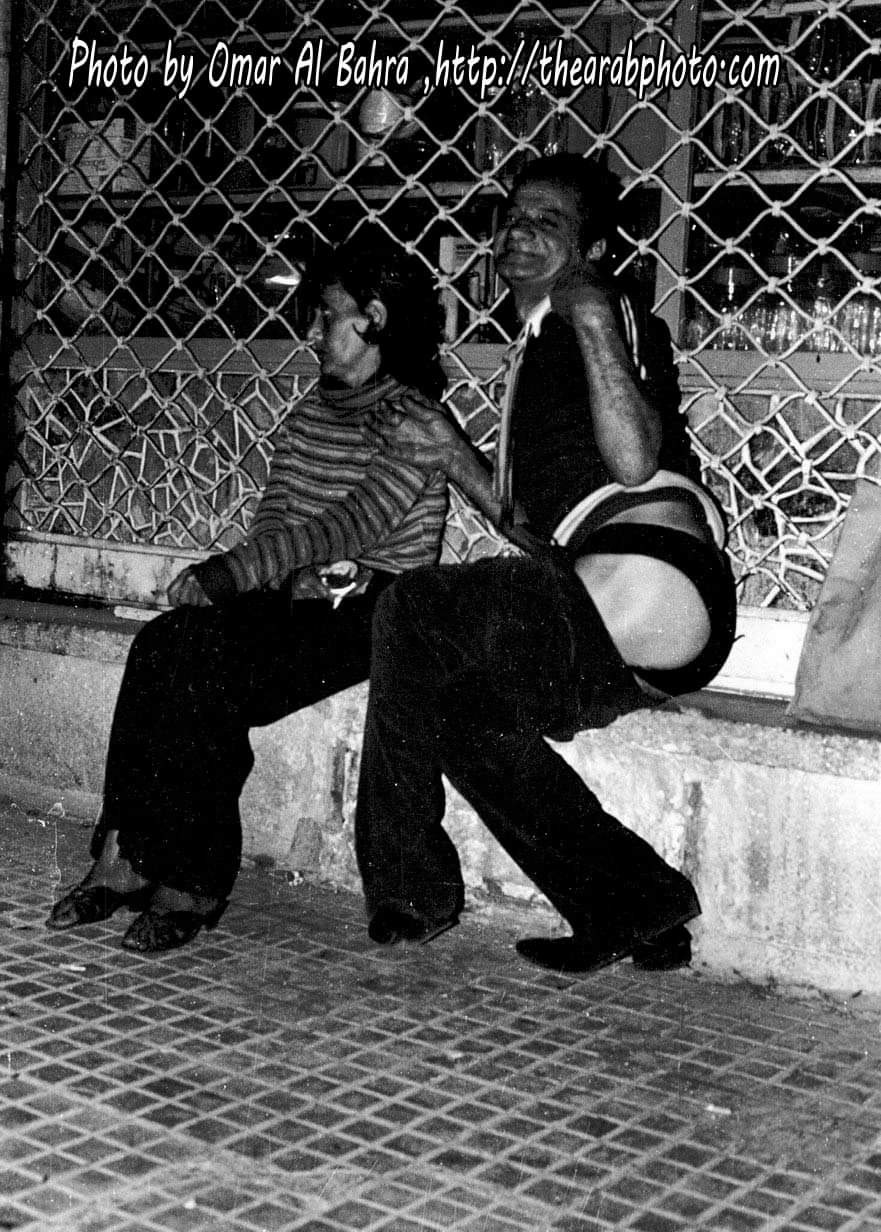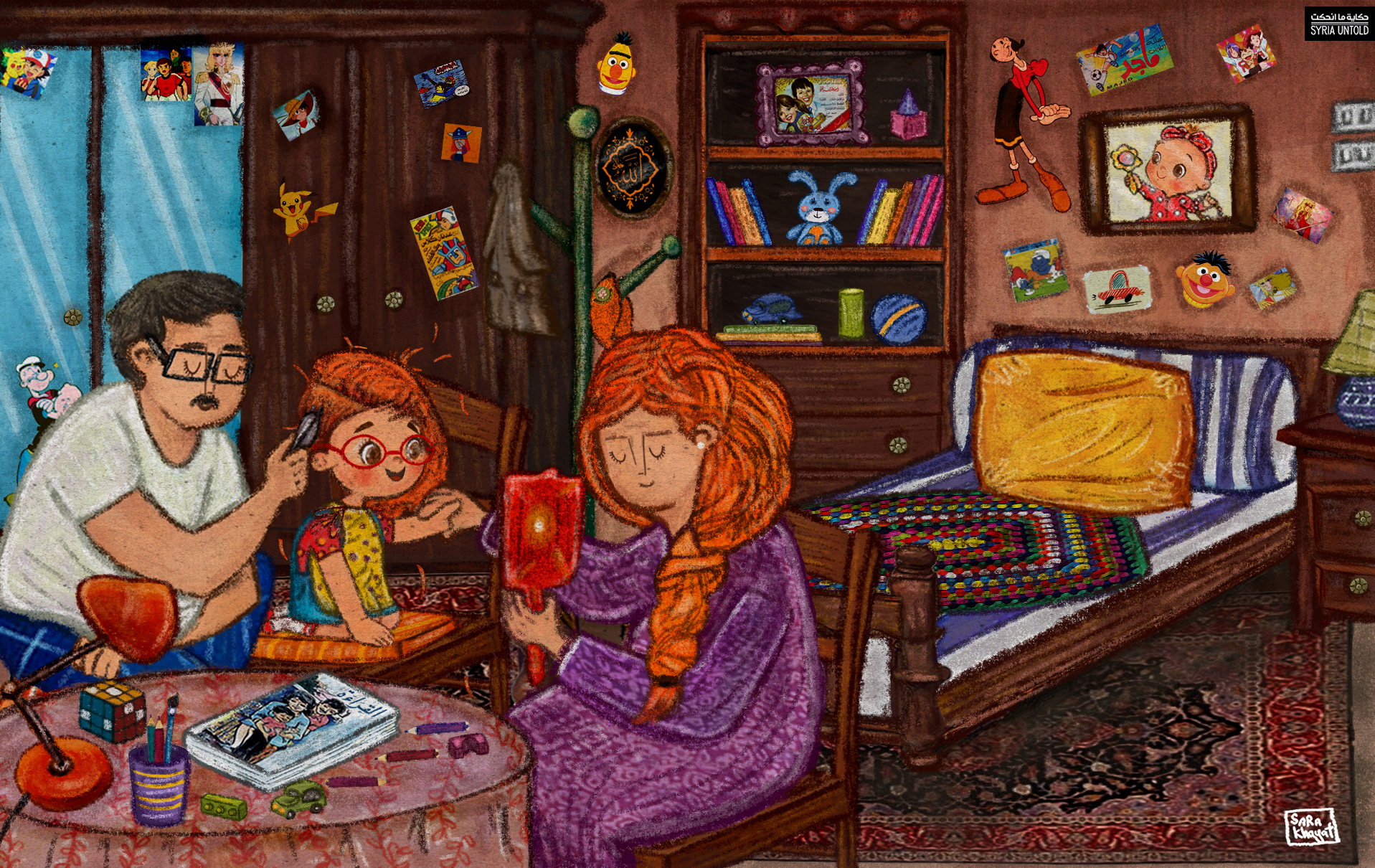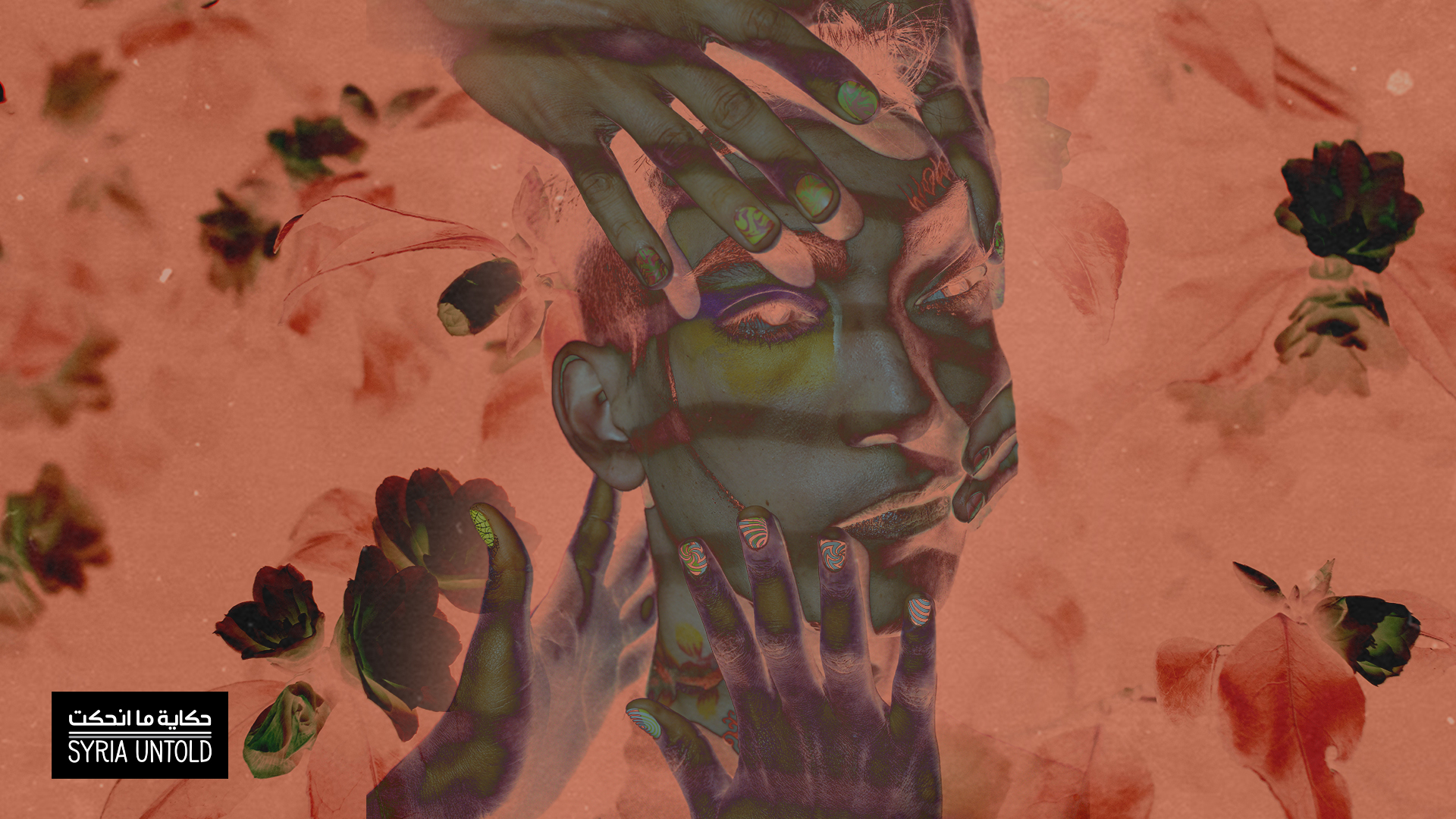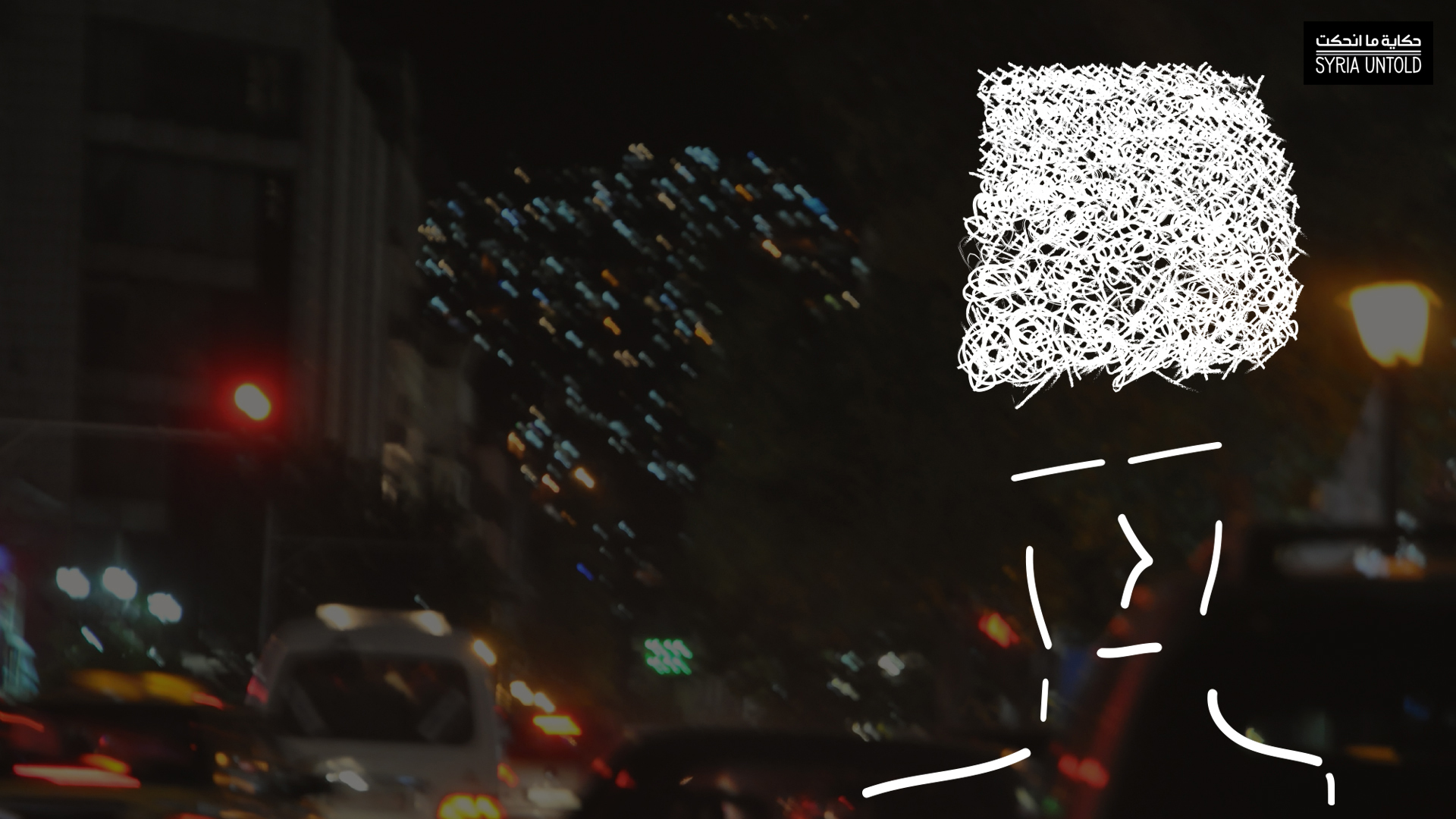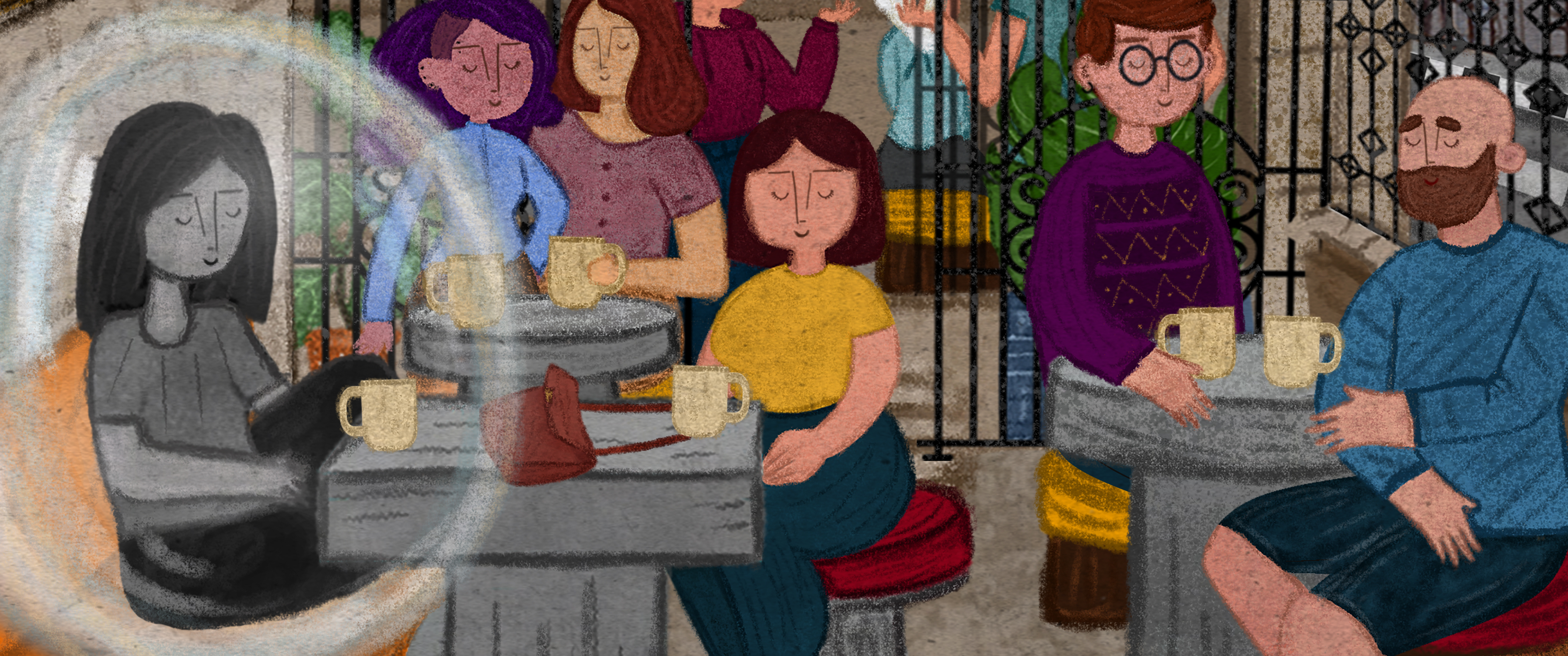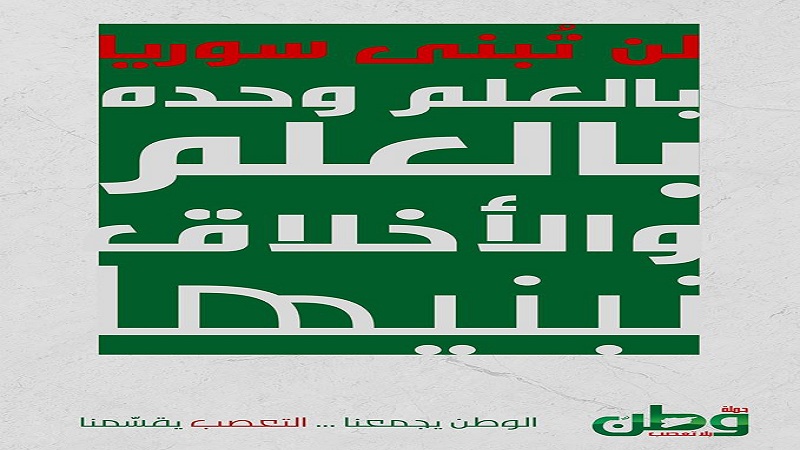You could be forgiven, when watching the 1979 theatrical play Kasak ya Watan (Cheers to You, Nation!)(1), for not giving a second thought to Atiyat, a male character with “feminine” mannerisms and attire who accompanies Fadiha Harakat, a dancer. The short scene is not particularly memorable and may barely solicit a reaction from viewers, except perhaps some giggles at the contrast between actor Housam Tahsin Bek, playing the role of Atiyat in this play, and his previous roles. What if I were to tell you, however, that this small role was based on a real person named Zuzu living in Damascus at the time?
Some may say that trying to project Atiyat's character onto a specific person is unrealistic, especially since neither the late playwright Muhammad al-Maghut nor the actor Housam Tahsin Bek ever spoke of such a connection.
In this article, I will demonstrate how easy it is to draw this connection through the testimonies of four individuals who lived during that period, including some who knew Zuzu personally. These interviews were conducted in the context of an oral history documentation. The testimonies also paint a picture of the prevailing Damascene public opinion of Zuzu, a character who is decidedly non-conforming in his sexuality and gender expression living in the Syrian capital.
Reimagining the queer characters of Syrian TV
19 August 2022
Salina: Untitled
22 July 2022
These personal testimonies and what they tell us about Zuzu represent the main part of the oral history that guided me in writing this article, in addition to analyses of the way the character of Atiyat dressed, behaved and walked, attributes that match greatly those of Zuzu.
This study prompts us to re-examine our current understanding of the characters represented by Syrian theater to better understand part of our history, the evolution of our societies and the ways in which they approached some sensitive issues such as gender and sexuality. Through this article, we will discover that Atiyat's role in Kasak ya Watan, which lasted no more than four minutes, improves our understanding of the way Syrian society addressed characters with non-conforming and non-normative sexualities and gender identities. Such an endeavor is particularly important for this historical period, in which little is known about the experience of LGBTQI communities, except through the lens of the art, memory and oral history of those who have lived it.
Zuzu: A unique social phenomenon in Syrian theater
Syrian theater was always particularly progressive, from its earliest beginnings with Abu Khalil al-Qabbani, the “father of Syrian theater,” who pushed the boundaries of religious and political restrictions. Religious authorities were quick to incite against his work, resulting in his theater being burnt in 1875. A few years later, his detractors gathered signatures on a statement from Damascene notables, which was raised to the Ottoman Sultanate. As a result, in 1883, his theater was closed, and he was no longer allowed to perform (2).
Many years later, in 1960, the late Muhammad al-Maghut went further, taking the liberty to represent reality in all its political, religious, economic and social dimensions. Not only did he address political and religious taboos but also challenged hegemonic patriarchy in the Syrian context.
His play Kasak ya Watan constituted a unique case. Not only was it daring politically, with critics considering it one of the most important and politically engaged plays of its time and place. It was also the first form of cultural production which depicted a known person in the Damascene LGBTQI community of the 1970s and 1980s, a genuine and realistic representation that successfully avoided misconceptions and stereotypes.
Atiyat's role in Kasak ya Watan, which lasted no more than four minutes, improves our understanding of the way Syrian society addressed characters with non-conforming and non-normative sexualities and gender identities
Kasak ya Watan can be considered a sacred ritual all Syrians observe on national or religious holidays. Men, women, and children alike gather around their television sets to watch reruns on Syrian and satellite channels alike. When it first came out, it constituted an artistic and intellectual act of rebellion against the concepts, ideologies and stereotypes engulfing Arab societies. The play toured more than nine Arab countries and was so popular it often was extended, as was the case during the first performances on Carthage Theater in Tunisia in 1979, as well as the UAE and Kuwait in 1980.
This play continues to live on in the collective memory of Arabs in general and Syrians in particular. Its characters and sociopolitical undertones are remembered as a challenge to the belief systems that Arab regimes sought to impose, particularly in the aftermath of the Six-Day War. Such a challenge could not have come to pass if it wasn’t for the intelligence and acumen of al-Maghut, who used satire and art to resist normalizing defeat, the denial of facts and the passive acceptance of poverty, ignorance and dictatorship, as well as the backwardness, authoritarianism and subjugation this entailed. Perhaps the greatest testament to the success of al-Maghut’s vision is the fact that his play continues to resonate with the lived reality of Syrians 43 years later, a reality marked by bureaucracy, corruption and the unattainability of basic services and needs.
Kasak ya Watan was first shown on stage in Damascus in 1979. The inaugural performance was attended by high-profile statesmen at the time, such as President Hafez al-Assad, Mustafa Tlass, the Minister of Defense, and Najah al Attar, Minister of Culture and National Guidance. A challenging and intimidating audience for the performers, to say the least, the latter had to repeat their lines, with the open and implied criticism to political authority these lines carried, as rehearsed and prepared without any erasures or modification.
Thank you, Um Kamel!
To the sound of applause and whistling, Hala Shawkat appeared on stage in the role of the dancer Fadiha Harkat, followed by Housam Tahsin Bek in the role of Atiyat, “her dresser.” Atiyat makes her appearance wearing bell-bottom trousers, a sleeveless black shirt, and a black scarf around her neck. She prances on stage in all her feminine glory, putting “Fa’ashat” or brass cymbals on her fingers. Her dress and mannerism did not provoke the audience. On the contrary, they loved the character and welcomed all its details. One of the people, who wished to remain anonymous, working on the set decoration at the time, said he was present for each show and not once did he witness a negative reaction from the audience. People were always eager for her appearance next to Fadiha Harkat.
Atiyat was never a purely fictitious character conjured from thin air, nor was she an empty addition to the cast, as many still believe, inside or outside Syria. She was the representation and embodiment of one of the most important and famous gender non-conforming persons known at that time in Damascus, Zuhair — also known as Zuzu or Aziza. These were Zuhair’s nicknames within his chosen family, the Rizk family, itself named “after the Egyptian artist Amina Rizk” in the “jaw”.
The “jaw” is the term gays and transwomen use in Syria to refer to the LGBTQI community. The term began to gain traction in the 1960s and replaced the term “meftah w ‘efel,” which could be translated to “key and lock”. Within the “jaw”, it was customary for someone to belong to a group that became their second, chosen family and with whom they could live their gender identity/expression and sexuality freely. Thus, the person became part of a large LGBTQI network that consisted of many families, each of which had a name. Zuzu chose to be affiliated with one of the older “jaw” families back in the 1970s. It was also customary for people, when they integrated in the “jaw”, to choose a sort of stage name which derived from their legal name. That is how Zuhair became Aziza; Zuzu for short (3).
“Zuzu al-Farfour al-Ghandour” (the soft, effeminate, prancing Zuzu), as Damascenes liked to call him in their private gatherings, has become a proverb in conversations: “Don't dance like Zuzu.” Zuzu is part of the collective memory of Damascus. The audience liked to evoke the character of Zuzu, especially since the actor Housam Tahsin Bek perfected his impersonation, down to Zuzu’s bell-bottom pants, neck scarf, sleeveless shirt and women's bag among other details. For example, Atiyat is the dresser of Fadiha Harakat which coincides rather conveniently with Zuzu's close relationship with the dancers in the famous al-Tahouna al-Hamra’ club in central Damascus, the name being an Arabic translation of the French “Moulin Rouge” and the club being considered a Syrian version of it. Zuzu was the link between the dancers and his friend Amin, or “Amina.” The latter was Zuzu’s chosen mother in the “jaw” and worked in dressmaking and fashion design. She regularly designed the dresses of the dancers of al Tahouna al Hamra’ (4).
In the play, Atiyat corrects Sabah al-Jaza’ery when she refers to her as “miss”, insisting she’s a madam and Sabah could only oblige and apologize. At first glance, this detail may seem trivial until we know that it represented a conversation that Zuzu was known to raise up with those he encountered on the streets of Abu Rummaneh, Al Salihiya Gate, and Sha’alan Street. He was no Miss, but the madame of the son of a former Syrian official.
It is worth emphasizing here the respect with which Atiyat’s self-representation was treated, as indicated by the behavior of Sabah al-Jaza’ery who respected her chosen pronouns without discussion. This is especially noteworthy when we consider how more contemporary media and art tend to represent gender and sexual non-conformity through the lens of dominant social norms.
Was the representation of Zuzu as Atiyat a stereotyping of Syrian gay men in that period?
To some, the representation of Zuzu may seem like a stereotypical one, but I would argue that was not the case. All those who have known Zuzu in Damascus think that there was no fiction in the way the character of Atiyat was constructed, she was very much a faithful and respectful representation of Zuzu, one that is devoid of exaggeration, belittling, or prejudice. Others may argue that the purpose of Atiyat as a character was ridicule and derision. However, the reaction of the audience contradicts such a claim. At every performance, Atiyat was met with applause and approval. We must keep in mind the context in which this play came to be. At the time, Zuzu represented a unique case in Damascene society, a character that had to be immortalized in an artistic representation, especially that the arts play an essential role in the oral history of the society from which they emerge.
On the stage of the Andalus Cinema in Kuwait on March 2, 1980, the dancer Fadiha Harkat appeared, followed by Atiyat with her overwhelming femininity, amid applause and welcome from the Kuwaiti audience, who did not condemn the presence of a character so clearly representative of the LGBT community. Her appearance was welcomed warmly.
“Zuzu al-Farfour al-Ghandour” (the soft, effeminate, prancing Zuzu), as Damascenes liked to call him in their private gatherings, has become a proverb in conversations: “Don't dance like Zuzu.”
In the filmed version of the complete play on YouTube, which was a recording from the stage of the Abu Dhabi theater in 1980, we can also note that the Emirati audience did not have any negative reaction towards Atiyat’s appearance, her dress, or even her pronouns. Her appearance at the side of Fadiha Harakat was, once more, met with applause.
Laila, a 60-year-old engineer and mother of three, often re-watches Kasak ya Watan. The play brings her back to an important phase in her life and that of her country. It was a time before what would come to be known as the Saudi revival, which would reinforce extremism and the authority of religious institutions on all aspects of Kuwaiti life. Inevitably, such changes would reach cultural productions as well: “Every time I watch Kasak Ya Watan and Atiyat makes her appearance, I feel nostalgic for the night when Atiyat appeared live on stage. Kuwaiti society, as I knew it at the time, was not crippled with extremism and the hatred of divergent sexual identities. Quite the opposite, people loved Atiyat. When her scene ended, the public stood up and demanded her return. A stark contrast to the society I live in now and which is filled with hatred to all gender and sexual differences.”
On childhood, ‘being different’ and memory
10 June 2022
Strategies for rebellion: A queer reading of the Syrian revolution
06 October 2020
Laila continues, “one of my father's friends told me that he heard from one of his Syrian agents that Atiyat's character is a real-life personality. A young man who lives in Damascus and is known by the name of Zuzu. He is often seen in an area called Abu Rummaneh. In the summer of 1986, I visited Syria and went directly to the Abu Rummaneh area to ask about Zuzu. Unfortunately, many shop owners told me that he suddenly disappeared. It was said he was found dead in his house several days after his disappearance in 1983.”
To some, including Laila, the search for Atiyat is an act of preserving a memory and a history. As I have argued, Atiyat is not so much a humorous character as she is a witness to the social context of the time, hence Laila’s comparison of Kuwait then and now. By saying that social acceptance changes with the context examined, I am in no way implying that gay marriage, for example, would’ve been accepted at the time. Nor am I saying, as some would argue, that society was willing to tolerate the existence of characters such as Atiyat or Zuzu as long as their existence did not disturb social order or bother others. I am not trying to justify or deny social control over sexual or gender non-conforming bodies, which limits their existence to pre-established social norms. I am rather attempting to objectively analyze that historical period, based on the testimonies of persons who lived through that period, away from orientalist stereotypes and pre-conceptions that ignore the very public existence of these characters.
Zuzu, a case of Damascene nostalgia
Sanaa is a housewife in the Abu Rummaneh area of Damascus, near the Noura parking lot, or the “Zuziyat stronghold” as Sanaa calls it in reference to the fact that Zuzu and his friends used to hang out there. Sanaa tells us that, “Atiyat’s scene in Kasak ya Watan always brings back memories. I am from the generation that knew Zuzu. He liked to come to the gates of al Salam School in the Sha’alan area at the end of the school day when the girls left school and the boys lined up on the side of the road. He would make sure to display his feminine catwalk, throwing glares and accusations of jealousy in our direction. When asked about Atiyat, he would act revolted, insisting the role was written for him personally. He refused to act in the play but coached Housam Tahsin Bek. We didn’t believe a word he said but no one would ever confront him about it, preferring to keep the peace and avoid his sharp tongue. Whether one liked him or not does not matter, he never harmed anyone and only insulted those who verbally abused him first. Perhaps the clearest evidence of social acceptance of difference in Damascus of that time, was that people accepted his presence without intervening in his life, as well as the warmth and applause that Atiyat was met with each time on stage.
Bassam (not his real name) was Zuzu’s chosen brother in the Rizk family. At seventy, he is now retired and lives in Damascus. When he is overcome with loneliness, Bassam heads to Maktab Anbar to visit his friend’s grave which is located in the Sheikh Khaled of the Rukn al Din area. Bassam believes that Kasak ya Watan was an indirect attempt to clear Zuzu’s name from the accusation of espionage that continued even after his death. That is Bassam’s explanation for Atiyat’s final line: “Israel, where will you go, you Zionist?” To earn a living, Zuzu worked as a house cleaner for a number of high-profile officials. His physical proximity to power, combined with the picture he always carried in a necklace of his visit to Jerusalem, led to rumors about him leaking information to the Israeli army. Despite the fact that, as Bassam reminds us, Syrian citizens were only forbidden from visiting Jerusalem after the Naksa of the Six-Day War, in 1967.
At the time, Zuzu represented a unique case in Damascene society, a character that had to be immortalized in an artistic representation, especially that the arts play an essential role in the oral history of the society from which they emerge.
Bassam recounts: “One night, we were hanging out at the Maktab Anbar on the main street of Sha’alan, when Aziza, or Zuzu as we liked to call her, came and told us how Mustafa Tlass, the Minister of Defense at the time, gave her ten tickets to the play Kasak Ya Watan. According to her, when Tlass saw Atiyat on stage, he remarked to Hafez al Assad: ‘this is a representation of Zuzu, the boy who cleans the mirrors and chandeliers in my house.”
Bassam continues that, “Aziza ‘Zuzu’ told us how Tlass promised her she will soon find herself playing main roles in plays. When Zuzu saw Atiyat enter on stage she was not impressed, ‘such poor acting, I can do much better than this loser...’”. She did, however, try to catch Housam Tahsin Bek after the play, but he had already left.
Bassam concludes his testimony by saying: “Very few people in society were unfair to Zuzu, but al-Maghut did him justice indeed.”
In the end, we can neither confirm nor refute the idea that the character of Atiyat was conceived based on Zuzu, no matter how well the two matched. We leave it up to the readers to make their own conclusions. What we can say for sure is that forty-three years ago, al-Maghut’s play was fair in its representation of Atiyat, something we can sadly not say of more contemporary works which exploit and mock individuals of non-conforming sexualities and gender identities through their representation.
Notes:
(1) Written by Muhammad al-Maghut, directed by Khaldoun al-Maleh, and starring Duraid Lahham
(2) Khalaf, Taissier (2019). Waqāʼiʻ masraḥ Abī Khalīl al-Qabbānī fī Dimashq, 1883-1873: ḥaqāʼiq wa-wathāʼiq tunsharu lil-marrah al-ūlá (The events of Abu Khalil Qabbani's theatre in Damascus, 1883-1873: facts and documents published for the first time) (in Arabic). Manshūrāt al-Mutawassiṭ.
(3) To learn more about al-Jaw and its history, read the following article: https://raseef22.net/article/1082257-سيفونة-دوتا-مطمطشيت-بعض-مصطلحات-وخفايا-مجتمع-المثليين-في-سوريا
(4) This information is based on an interview with Bassam (pseudonym).


